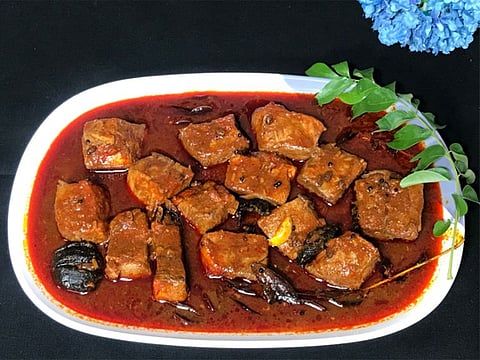Traditional Kerala recipe for Meen Vevichathu or red fish curry
Often eaten with steamed and mashed tapioca (kappa), this dish is a blend of spices

Made from using the goodness of cambodge or kudampuli, this dish is quite popular in the southern state of Kerala in India. This traditional dish also goes by the names 'meen vevichathu' and even 'kudampuli itta meen curry' and takes less than half an hour to cook to perfection. You can use any kind of Indian fish, but for this recipe I have used the Indian salmon fish (rawas). The dish tastes great with steamed rice, kappa (tapioca), chapatti (wheat flatbreads), puttu (rice steam cakes), pathiri (rice pancakes)... anything you like!
So, here's how you can prepare it...
Preparation time: 10 minutes
Cooking time: 25 minutes
Servings: 6 - 8
Ingredients:
Method:
Step 1: Wash and clean the fish pieces thoroughly. Once you drain the water, keep it aside.
Step 2: Next, wash and rinse the cambodge (kudampuli) well and then soak it in half a cup of water for 10 minutes. While you wait for the cambodge to be soaked, chop the ginger into small pieces, chop the garlic cloves and slice the shallots lengthwise. Keep them aside, in separate bowls.
Step 3: To a thick-bottomed pan (preferably earthenware or manchatti to get the authentic taste), pour two and half teaspoon of coconut oil. Swirl the pot in such a way that the oil is coated evenly all over the manchatti or earthen pot.
Step 4: Add the fenugreek into the oil and stir it. After a few seconds, add in the mustard seeds and allow it to splutter.
Step 5: Lower the flame and add the sliced shallots. Stir it for another 30 seconds. Then add the garlic cloves and chopped ginger and stir it once again for a few seconds.
Step 6: Add ginger-garlic paste and sauté it until the raw flavour of mix is gone.
Step 7: Further lower the flame, and then add chilli powder and turmeric powder. Sauté for a few more seconds. Ensure that your mix doesn't get over-fried or burnt.
Step 8: Add water and the soaked cambodge into the mix. Adjust the salt according to taste and also add a pinch of asafoetida (hing).
Step 9: Finally, add the fish pieces and then place three sprigs of curry leaves on the top of the mix. Allow it to boil on a medium to high flame. Once it starts boiling, close the clay pot with a lid.
Step 10: Cook for about 10 minutes. You can also swirl the pot once or twice to evenly spread out the flavour.
Step 11: Bring the flame to a low and cook for another 10 minutes without the lid. You will see the oil settling on top of the gravy as a thin layer.
Step 12: Switch the flame off. Let the curry sit for another 30 minutes before serving it with hot tapioca or steamed rice.
Cooking notes:
1. Kashmiri chilli powder has less heat but gives a vibrant red colour. 2. To increase the spice, add regular chilli powder and reduce the addition of Kashmiri chilli powder. 3. This curry tastes much better when served the next day. So, boil it once again and use it the next day as well. 4. As far as possible, use coconut oil or else use any other cooking oil, as per your preference.
Sign up for the Daily Briefing
Get the latest news and updates straight to your inbox











